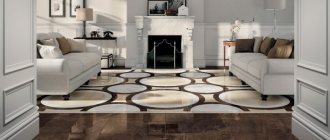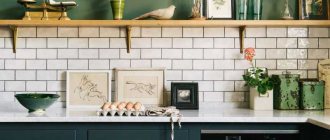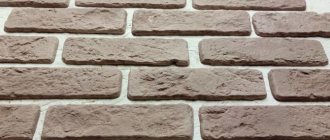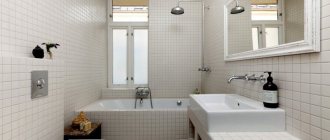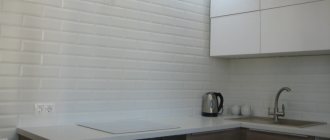The appearance of the living room can completely characterize the owners of an apartment or country house. Therefore, its design is always given special importance.
The floor in such a room should be as smooth and comfortable as possible, for which various types of covering are used - parquet, laminate or linoleum.
But ceramic tiles are not very often found in the living room, although this option is convenient and practical.
Tiles in the living room: advantages of placement
Tiles should be laid on the floor in many rooms, including living spaces, due to:
- durability;
- high resistance to scratches and cracks;
- the possibility of placing equipment with significant weight on it.
The surface covered with tiles does not deform or deteriorate, even if heavy elements supporting various equipment rest on it for many years. The material will also not be damaged when renovating the living room or moving furniture across the floor.
With tiled floors, keeping the area clean is easy and cleaning up any dirt is quick and easy. This is especially important in the living room, which is the showcase of the home where you invite friends. In addition, the hall is one of the rooms that is most often used by all family members.
To clean the tiles, use a cloth or mop and any cleaning products.
More popular floor finishing materials do not provide the same soundproofing effect as tiles. Movement on the tiled floor is silent, especially when walking in socks. In this option, there is no need to be afraid that the large living room will have an echo.
Tiles can be used in all "tight" spaces: under tables and chairs, where the constant movement of furniture quickly wears out wood panels, and around the fireplace, where the temperature varies and can be high. Moreover, heated floors can be used under the tiles.
Miniature tiles
An amazing and truly unique floor design was created using small mosaic tiles from the same masters from Eco Ceramica.
Tiles in the living room interior: disadvantages
Using tiles in the living room has its disadvantages, but they are incomparably fewer than the advantages. First of all, the tiled floor will have a lower temperature. The solution to this problem is to install heating from below, but this creates additional costs: one-time and monthly. An easier and cheaper solution is to place thick carpet in areas where the cold is most unpleasant. Unfortunately, tiling the entire floor will take away from the elegant effect you would like to achieve.
Classic floor tiles create visual coolness. Rather, they will not give the apartment a warm homely atmosphere. Glossy tiles in combination with furniture finishing to a high gloss will contribute to the effect known from the image of shopping centers. It’s definitely worth making at least one element of the floor or furniture matte.
Advantages and disadvantages
Today, tiles for finishing the floor in a room rank first in popularity. Externally, the surface is a kind of mosaic with more or less distinct boundaries of the fragments. At the same time, the fragments themselves differ in size, shape and color. In essence, the technology is no different from wall cladding. The only difference is in the thickness of the tiles: floor options are thicker and heavier.
Tile flooring combines reliability and attractive appearance
Advantages of floor tiles:
- Long service life, ability to withstand large loads and maintain an attractive appearance.
- It practically “does not react” to mechanical stress and is resistant to abrasion.
- Tile models are available that are not susceptible to fading in the sun and retain their original color during the period of use.
- It is extremely easy to maintain and can easily withstand not only wet cleaning, but also the use of chemicals and abrasives.
- Today, a wide range of color solutions is available, guaranteeing an “exact fit” into the interior of any palette and style.
- Modern tiles are made from different materials, which means you can find an option with the performance characteristics that you need (tiles in the living room, cork flooring or porcelain tiles - you choose).
- Laying tiles on the floor is not difficult; many people do it themselves, without involving specialists.
- Depending on the type of raw material, the size of the fragment and the complexity of the design, the cost of the tile also changes. You will always find an option that suits you not only in appearance, but also in price.
Unfortunately, there are also disadvantages:
- Especially in the cold season, tiles on the floor are very uncomfortable, so if possible, consider additional heating.
- Smooth surfaces (also called “glass-like”) are very slippery, which not only causes discomfort, but can be hazardous to health.
- Some materials emit characteristic sounds, each step is accompanied by a “clunking” sound, and not everyone likes this.
Living room design: tiles for different interior styles
Tiles are a popular product and are therefore available in various sizes, colors and shades. It is covered with all kinds of patterns. The tiles can imitate wood, white marble, natural stone or raw concrete. The final choice will affect the character of the living room:
- elegant;
- minimalistic;
- rustic.
When looking for an idea for a decorative, colorful floor with eye-catching patterns, you should turn to ceramic tiles - a wide selection allows you to lay out a ceramic rug in the interior, or give the space a palace or even oriental style.
Living room floor tiles: which option to choose?
Regardless of the size of the living room, large format tiles are ideal for laying on the floor. They contribute to the optical enlargement of space and give the effect of consistency. The fewer gaps that are left between the tiles and the thinner the seam, the more pronounced the effect will be.
Large format tiles come in a variety of shapes and colors. Squares and rectangles on different sides should be selected in such a way that cutting the tiles is not required or occurs on the smallest possible surface. The key here is to know how to install large format tiles. It's also a good idea to measure the living room so that the tiles at the ends of the living room are the same length, rather than one being the original size and one being significantly shorter.
Tile flooring can easily be matched to a modern, Provençal or rustic room. It all depends on the pattern of the ceramic finish. It can reproduce different types of wood, their exact patterns and rings. It can also successfully replace natural stone - travertine, granite or marble. There are models that look deceptively like trendy concrete.
It's no surprise that tiles are very popular in the interior design industry today. Moreover, its durability and resistance are better than, for example, laminate.
White, gray and wood - trends of the season
Currently, the most fashionable colors will be patterns that imitate natural marble, gray or beige. These shades will perfectly match the minimalist interior design trend. They will create a uniform floor plane and a clear contrast with other surfaces, such as contrasting walls. In turn, a white floor, especially in small living rooms, will optically increase the space.
Color scheme and texture
First of all, the color of the flooring in the living room depends on your preferences. According to designers, the most practical and frequently used colors are coffee shades, as well as terracotta and sand yellow. Often a gray brick or stone tone is chosen for the floor.
When choosing the color of floor tiles, it is important to consider the size of the room. In a small living room it is better to lay light flooring
A stylish and expressive floor design comes from combining several colors on one surface.
Black color, although it looks unusual, is still inappropriate in the living room. It visually makes the room low and heavy, even if there are light inclusions. But smoky blue or gray-mint colors, diluted with beige or gray fragments, make the living room interesting and do not interrupt the overall design concept.
Gray tiles are perfect for flooring in a modern living room
Clearly shaped tiles in neutral shades help create a strictly and laconic design
In the interior of a modern living room, black and white tiles laid out with a geometric pattern look original.
The texture of modern tiles is more varied than ever. And if previously you had to choose between a glossy surface and a not so glossy one, today tiles with interesting effects and even 3D models are available. You can choose a matte finish, rough tiles or embossed tiles.
Glossy tiles attract attention with their perfectly smooth surface and shine.
By choosing the right tiles, taking into account the lighting of the room and the palette of wall decoration, you will turn the living room into a work of design art. It will always be a pleasure for you and your loved ones to be in such a room.
Kitchen-living room: tiles and laminate
Tiles on the floor in the kitchen-living room are the ideal solution. Especially if it is combined with the laminate flooring of the living room, zoning the useful space of the common room.
The tiles are offered in a huge range of colors. You can use attractive designs that are hard to find on wood or laminate floors. Tiles can be used to create a uniform, elegant floor. Especially when you choose large plain options, for example, 60 × 60 cm or even 75 × 75 cm. A uniform surface, for example, imitating concrete, is most easily achieved using straightened tiles (the edges are cut at right angles). Modern concrete tiles have a size of 75 × 75 cm, which allows them to create an almost uniform floor.
If you like shiny floors, then no other material is as good as polished ceramic tiles. The shiny surface will beautifully reflect and diffuse light, illuminating the entire room. A tiled floor is ideal when the living room is connected to the kitchen - thanks to the tiles, the floor will be uniform, optically connecting both rooms.
Wood-effect tiles are perfect for both the living room and the kitchen. Ceramic tiles are an ideal idea for people who love wood on their floors, but want to avoid the hassle of maintaining, cleaning, and varnishing them. Tiles may look like different types of planks, but they are much easier to maintain. Platinum, laid out in a classic style, resembles a wooden parquet floor.
It should be remembered that unglazed porcelain or natural stone tiles will require impregnation, which will protect their surface from dirt getting into the structure and unsightly discoloration. All other types of tiles do not require such care.
Tiles imitating wood cladding
The Italian company Iris Ceramica decided to release an unusual French Woods collection - tiles with decorative elements that look as if they were made of wood.
A truly mesmerizing look of the floor surface is created by tiles with a coating that imitates petrified wood, a masterpiece from the Kauri Collection assortment from the American company Oregon Tile and Marble. This is a great example of how flooring can enhance a living room.
Heated living room floor tiles
When planning underfloor heating in your home or apartment, ceramic tiles are the best solution. This duo is perfectly complemented by tiles that conduct heat well. Heated floors make cold surfaces warmer, making them extremely pleasant to step on. Ceramic tiles are very durable and resistant to damage. There are no problems cleaning them. When purchasing them, pay attention to the abrasion class. In the living room you can successfully use tiles labeled PEI 3/750, but for high-use areas it is better to choose those that have a higher resistance, such as PEI 3/1500. The PEI symbol is a measure of the resistance of glazed tiles to surface abrasion - the higher the PEI value, the higher the grade of the tile.
The floor tiles in the living room are practical and beautifully presented in the photo gallery. In addition, they are ideal for the popular underfloor heating. Check out this season's trendiest arrangements.
What is important to consider when choosing
When choosing high-quality and inexpensive tiles, it is necessary to take into account its environmental friendliness and compliance with sanitary requirements. The higher the porosity of the structure, the greater the likelihood of poor maintenance, but we must not forget about the appearance of the coating, because the tiles should decorate the room.
When planning an upcoming renovation, it is important not to forget about the floor covering, and if you plan to install a heated floor system, tiles will be an ideal option. It warms up well and retains heat for a long time, and in the hot season it gives coolness, decorating the room.
